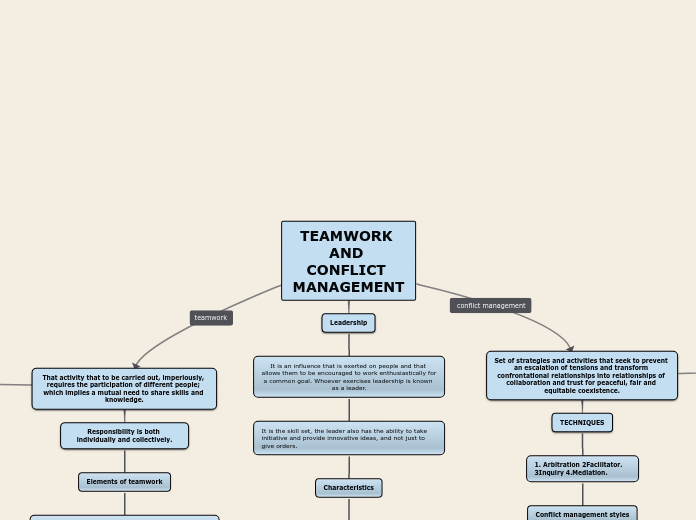TEAMWORK AND CONFLICT MANAGEMENT
Leadership
It is an influence that is exerted on people and that allows them to be encouraged to work enthusiastically for a common goal. Whoever exercises leadership is known as a leader.
It is the skill set, the leader also has the ability to take initiative and provide innovative ideas, and not just to give orders.
Characteristics
Have a positive thought
To be honest
Know how to delegate
Encourage good communication
Inspire the group
Establish strategies for a balanced life
Line up the team
Give credits when applicable
Encourage growth and Appreciate achievement
Maintain a neutral position
Elements
Culture
Values, principles
Skills, Capabilities
Processes, Methodologies
Tools
Leadership styles
Autocratic Leadership
Centralization of authority
The influence of a leader is determined by the use of power
Reactions to Organizational Culture
Submission
Endurance
Minimum acceptance of responsibility
Irritable
Antipathy
Democratic Leadership
Delegation of authority
The influence of the leader is determined by motivation
Reactions to Organizational Culture
High enthusiasm index
Higher quality and quantity of production
High team morale
Satisfaction of needs
Charismatic Leadership
Absence of authority
The influence of the leader is determined by the admiration of his followers
Reactions to Organizational Culture
Good motivation
Little use of power
Possible disorganization
Organizational Culture And Leadership
Characteristic attitudes, beliefs, values and habits within an organization
Teamwork
Committed, reliable, communicative and successful collaborators with the organization's objectives.
Ability to implement, facilitate and adapt an Organizational Culture
Process of adaptability to teamwork
Diagnosis of needs
Definition of objectives
Communication of decisions
Encourage behaviors
Institutionalize Organizational Culture
That activity that to be carried out, imperiously, requires the participation of different people; which implies a mutual need to share skills and knowledge.
Responsibility is both individually and collectively.
Elements of teamwork
Teamwork is based on "the 5 C's" to get the best results. Coordination, Complementarity, communication, trust and commitment
Norms for teamwork: They facilitate the execution of the planned goals or objectives according to how they are established.
Advantages in teamwork: Greater efficiency, a better work environment, greater success in work, Greater speed in the completion of work, Greater diversity in addressing the problem, Greater work capacity, Strengthening of cooperation and cohesion bonds
Cons: Dropouts
Liability can be diluted
Process delay
Possible tensions
Risk of dispersing energy
Set of strategies and activities that seek to prevent an escalation of tensions and transform confrontational relationships into relationships of collaboration and trust for peaceful, fair and equitable coexistence.
TECHNIQUES
1. Arbitration 2Facilitator. 3Inquiry 4.Mediation.
Conflict management styles
* Willing * Evasive * Committed * Collaborative * Competitive
